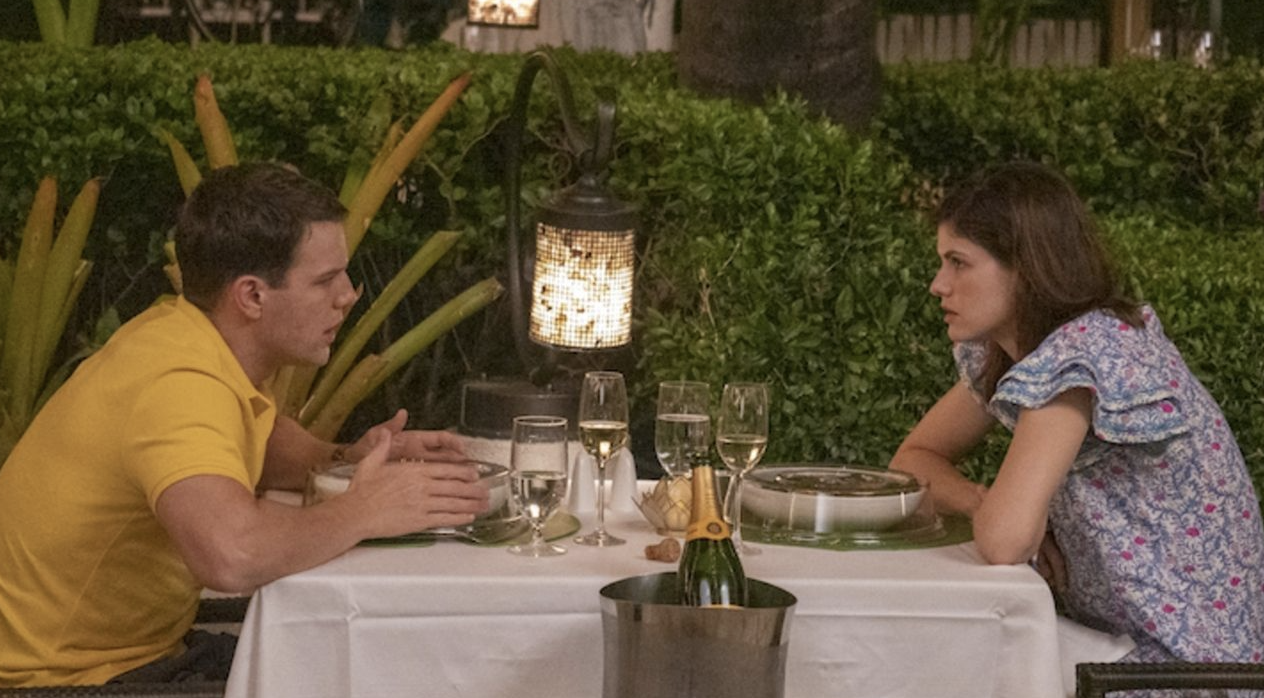Deep in the bizarre third episode of HBO’s The White Lotus, we see Mark (Steve Zahn) crawling towards his wife in bed, hooting and hollering in imitation of an ape. The gesture is uncomfortable in the extreme, a strange, animalistic dance of dominant masculinity. He clearly means to put on an air of sexual viability, but the heartless performance adds a degree of disconnect, leaving a sad man playing a tired role. Attempts at transformation define the characters of The White Lotus, with the self-absorbed elites populating the titular Hawaiian resort hitting the dead-ends of their respective lives. These include characters like Tanya (Jennifer Coolidge), seeking relief from her grief at the resort, and newlyweds Shane (Jake Lacy) and Rachel (Alexandra Daddario) attempting to define their married lives. However, all of these unsalvageable characters hit the same dead-end, finding that maybe new surroundings won’t change fundamental personal flaws.
Halfway through creator Mike White’s new HBO miniseries, The White Lotus still suffers from the same imbalanced tone and inconsistent writing that has plagued the project from the start. White focuses so intently on the guests and their horrifying and unlikable personalities that we spend so little time with the resort staff. Characters like resort manager Armond (Murray Bartlett) and Belinda (Natasha Rothwell) are, frankly, more interesting and nuanced, yet White seems to lean away from them. While this may be a conscious sidestepping of painting the staff as heroes and the guests as villains, this creative decision leaves the project off-balance. White may be adamant about not falling into a traditional class critique, but he fails to find a compelling direction for his project.
“Mysterious Monkeys” features the resort in disarray, with teenagers Olivia (Sydney Sweeney) and Paula (Brittany O’Grady) dealing with trust issues, Quinn (Fred Hechinger) experiencing digital device withdrawal, and Rachel and Shane attempting to figure out their sex lives. Tension builds as characters are paired together in unexpected ways, often initiated by Armond. The most entertaining pairing is surely Shane and Rachel being pushed off with Tanya, becoming pulled into the spreading of her mother’s ashes.
Tanya is the biggest enigma of The White Lotus, a character just as wealthy as the others but seemingly disconnected from the world they share. Coolidge is incredible in this episode, taking a character that can seem inscrutable and turning her into a somewhat relatable human being. She’s deeply broken and torn-up by the death of her mother, and is still tied to the expectations her mother had for her. Tanya is just trying to move on from the loss she is feeling, and Coolidge completely spellbinds in this week’s episode, walking the fine line between comedy and all-out, all-consuming grief.
Armond may be the only other truly compelling figure in The White Lotus at this point. However, this is undercut by White’s writing and plotting, much of which serves no real purpose to the characters. The show at this point is centered around Armond, with him serving as antagonist to several guests now, a resort manager agent of chaos toying with his guests. Yet he remains bizarrely underdeveloped for such a central character, carried almost entirely by Bartlett’s chameleonic performance. While Armond is one of the show’s only true joys, this dynamic seems to already be wearing out its welcome, unless Armond is developed in more interesting directions.
Instead of developing characters like Armond or Belinda, White is very focused on the drama involving Mark Mossbacher and his family while staying at the titular resort. The problem with this is the storylines involving the Mossbachers feel extremely stale and forced at every turn, failing to cohere or deepen in any meaningful way. Mark is threatened in his masculinity by the revelation that his father was in fact gay, and his wife Nicole (Connie Britton) is defined in equally vague terms. She’s a strict parent and very successful in her business, but is largely devoid of personality besides these traits. Mark and Nicole’s children don’t fare much better, defined by their cynicism and drug use and little else.
The White Lotus, now at the miniseries’ halfway point, is in desperate need of direction. Disparate elements of the miniseries do work: White’s sharp dialogue, a strong cast, and characters like Tanya and Armond stealing their scenes regularly. However, White’s show seems to be banging its head on a wall at this point, repeating the exact same points over and over again. The show seems to be a critique of class, a satire of the extremely white wealthiness of the central characters, yet it can’t divorce itself from the viewpoints of these characters. There’s no perspective here, just a parade of grotesque people living desperate lives. The show seems to illustrate the point that, by centering wealthy white individuals, it becomes virtually impossible to critique them in any meaningful way. Instead, White’s show becomes the very thing he is attempting to tear down. Like the characters of the show, The White Lotus seems to be hitting a dead-end, and needs to open itself up to transformation, to develop into something unexpected. By not doing this, White’s show remains lost at sea.
The White Lotus airs on Sundays 9:00 p.m. EST on HBO and also on HBOMax.
Advertisement
Advertisement
